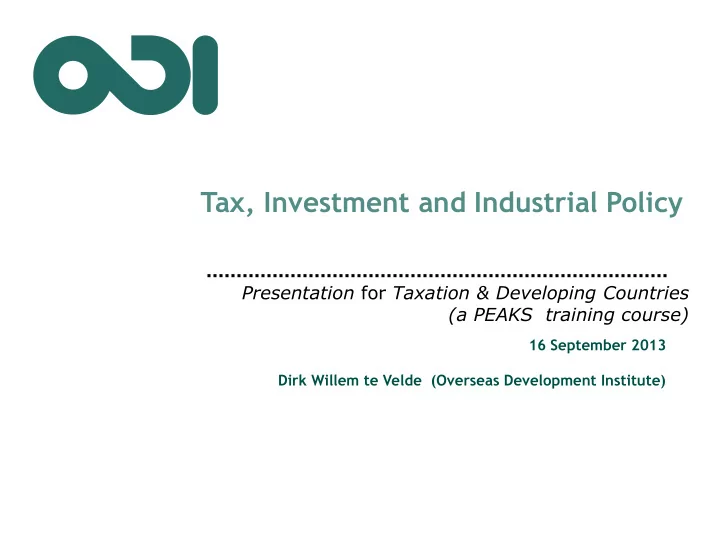

Tax, Investment and Industrial Policy Presentation for Taxation & Developing Countries (a PEAKS training course) 16 September 2013 Dirk Willem te Velde (Overseas Development Institute)
Overview Using taxation as industrial policy • Classifying investment incentives • WTO compliance • Impact of incentives (some considerations) • 2
Tax as Industrial Policy Trade tax incentives – (negative) protection is largely • discredited, but exemptions are still used (Corporate/investment) tax incentives to attract pioneer • sectors and encourage human capital formation (e.g. Singapore) or green innovation (e.g. R&D allowances), addressing market and co-ordination failures Tax incentives on their own or as part of a package (skills, • R&D, infra, clustering, zones), which requires implementation capacity, strategy, consistency, etc. Risk of mismanagement and fiscal problems • 3
Classification of Tax Incentives Corporate tax reductions, exemptions and • deductions – Low statutory tax rates, Preferential tax rates, tax holidays, others (loss-carry forward etc) Investment allowances and investment credit • Taxes on dividends, interests and capital gains • Taxes on inputs and imported goods • – VAT exemptions, reduced duties 4
WTO Compliance WTO rules constrain (to some extent) countries by • offering certain trade-distorting incentives in order to limit trade distortionary incentives. An incentive is an implicit subsidy Relevant agreements • – Agreement on Trade Related Investment Measures (TRIMS) – Agreement on Subsidies and Countervailing Measures (ACM) – Agreement on Agriculture (AoA) 5
Impact of Investment Incentives Literature on attracting FDI (econometric, economic, surveys, tax • lawyers): – Main determinants are market size, economic fundamentals, resource availability, etc; but – But incentives can be important at margin; and – Tax advisors look for countries with tax treaties (DTTs etc ) … Revenue foregone : • – What would have been fiscal revenues in the absence of incentives? Static (and dynamic) counterfactuals? Impact of incentives on investment levels, investment behaviour etc. • – Very little firm level evidence (mostly relying on first point!) Relation to governance, intra-state competition, corruption • 6
Investment Incentives Revenue Foregone and Link with Investment Caribbean examples of customs' revenue Firm level performance and losses from concessions, Incentives, St Lucia 1991-2003 (% of GDP) 1991- 2001- REVENUE LOSS/ IMPORT v/s INVESTMENT/ 1993 2003 SALES Antigua and Barbuda 5.1 9.2 1.2 Dominica 4.2 4.3 INVESTMENT/SALES 1 0.8 Grenada 11.4 11.3 0.6 0.4 St Kitts and Nevis 5.8 12.2 0.2 St Lucia 5.9 5.9 0 0 0.1 0.2 0.3 0.4 0.5 St Vincent and the Grenadines 6.7 6.1 REVENUE LOSS/IMPORT Source: Meyn et al (2008) Source: CREDIT report 7
Impact of SEZs on Jobs and Productivity Towards employment creation Singapore Malaysia Costa Rica Dominican Republic Mauritius Kenya Madagascar Ghana Lesotho Tanzania Nigeria Malawi Senegal Towards structural transformation 8
Some Concluding Thoughts Tax incentives do affect investment decisions and • behaviour, but there are strong doubts about whether the cost-benefit analysis is positive for host-countries Successful tax incentives are part of a • package/strategy. Principles for successful industrial policy also apply to tax incentives Fiscal incentives in weak governance contexts likely to • be most harmful But lack of good empirical studies • 9
Recommend
More recommend